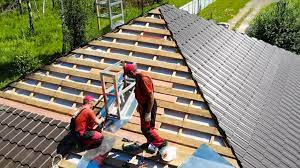A sagging roof is more than just an unsightly problem; it is an indication of structural issues that require immediate attention. Ignoring a sagging roof can result in additional damage, reduced energy efficiency, and even safety hazards. In this blog, we’ll look at the causes of a sagging roof, the structural issues it raises, and how to effectively address and repair the problem.
What Are the Causes of a Sagging Roof?
Before delving into how to repair a sagging roof, it’s critical to understand what’s causing the issue in the first place. A sagging roof can be caused by a variety of factors, including:
1. Roof Age: As roofing materials deteriorate over time, the structural integrity of the roof deteriorates. This is especially common in older homes with roofs that have passed their useful life.
2. Inadequate Roof Ventilation: Poor roof ventilation can lead to moisture buildup in the attic. Excess moisture can weaken the roof structure, causing sagging and other problems.
3. Roofing Materials: The type and quality of roofing materials used can affect the lifespan and structural stability of a roof. Sagging can be caused by low-quality materials or improper installation.
4. Overloading: Excessive weight on the roof, such as heavy snow accumulation or improper attic storage, can strain the roof structure and cause sagging.
5. Water Damage: Roof trusses, rafters, and the overall structure can be weakened by leaks or water damage. Moisture can rot wood and compromise the integrity of the roof.
6. Inadequate Support: Inadequate or improperly placed support beams, columns, or walls can result in insufficient load-bearing capacity, resulting in sagging.
A Sagging Roof’s Structural Issues
A sagging roof raises several structural concerns that must be addressed as soon as possible to avoid further damage and ensure the safety and integrity of your home. The following are some of the most serious structural issues associated with a sagging roof:
1. Weakening Roof Structure: Sagging roofs indicate that your roof’s supporting elements, such as trusses, rafters, or beams, have weakened or deteriorated. This jeopardizes your roof’s structural integrity.
2. Risk of Collapse: A severely sagging roof can collapse, especially if there is snow or heavy rain on top of it. This is not only a potential safety hazard, but also a financial disaster.
3. Water Damage: Sagging roofs frequently cause water pooling, which can aggravate or cause new leaks. Water damage can spread to your home’s attic, insulation, and interior, resulting in costly repairs.
4. Reduced Energy Efficiency: Gaps and openings in a sagging roof allow air infiltration and heat loss. This can result in decreased energy efficiency, higher utility bills, and home discomfort.
5. Aesthetic Issues: Aside from structural issues, a sagging roof can have a significant impact on the appearance of your home. It may cause visible dips or waves in the roofline, lowering curb appeal and decreasing property value.
Procedures for Addressing and Repairing a Sagging Roof
Addressing and repairing a sagging roof is a complex and potentially dangerous task that should only be undertaken by qualified professionals. The following are the steps involved in the process:
1. Inspection: Begin by inspecting the roof, attic, and supporting structure thoroughly. Examine the components for signs of damage, rot, or weakness. It is critical to determine the source of the sagging.
2. Remove Existing Roofing Materials: In most cases, the existing roofing materials must be removed in order to gain access to the underlying structure. Shingles, underlayment, and sheathing are all included.
3. Repair or Replace Structural Components: Depending on the extent of the damage, structural components such as trusses, rafters, or beams may need to be repaired or replaced. This is an important step in restoring the strength and integrity of the roof.
4. Reinforce Support: Reinforce or add support beams, columns, or walls as needed to ensure that the roof can withstand the load. Additional support structures in the attic or crawlspace may be required.
5. Address Attic Ventilation and Insulation: Proper attic ventilation and insulation are required to avoid future moisture buildup and damage. Check that the vents are properly installed and that the insulation is in good condition.
6. Install New Roofing Materials: Install New Roofing Materials: Once the underlying structure has been repaired and reinforced, new roofing materials can be installed. Underlayment, sheathing, and roofing shingles or other coverings are all examples of this.
7. Professional Inspection: Have a professional roofing contractor inspect the work after the roof repair Newton and installed with new roofing materials to ensure it meets industry standards and is safe and effective.
8. Regular Maintenance: Establish a regular maintenance routine to prevent future sagging or structural issues. Inspect your roof and attic on a regular basis for signs of damage, leaks, or moisture accumulation.
Sagging Roof Prevention in the Future
While repairing a sagging roof is critical, taking preventive measures can help avoid the problem entirely. Here are some preventative measures you can take to avoid sagging roofs in the future:
- Regular Roof and Attic Inspections: Conduct regular roof and attic inspections to identify and address potential problems early.
- Proper Ventilation: Make certain that your attic is properly ventilated to avoid moisture buildup, which can weaken the roof structure.
- Professional Installation: Select a reputable roofing contractor who is knowledgeable about proper installation techniques and high-quality materials.
- Limit Heavy Loads: To avoid excessive weight, avoid overloading your roof with heavy items and promptly remove snow or debris.
- Address Leaks: Repair any roof leaks as soon as possible to avoid water damage and rot.
- Invest in High-Quality Materials: Invest in high-quality roofing materials that are built to last.
Conclusion
A sagging roof is an obvious sign of structural issues that require immediate attention. Ignoring the problem can result in more serious damage, safety hazards, and costly repairs. If you notice any signs of a sagging roof, you should consult with a professional roofing contractor to determine the extent of the damage and the best course of action for repairing and restoring the structural integrity of your roof. Remember that addressing the problem as soon as possible not only ensures your safety and the protection of your home, but also extends the life and value of your roof. Find more information about Pinnacle Exteriors Inc and their expertise in addressing roofing issue.










